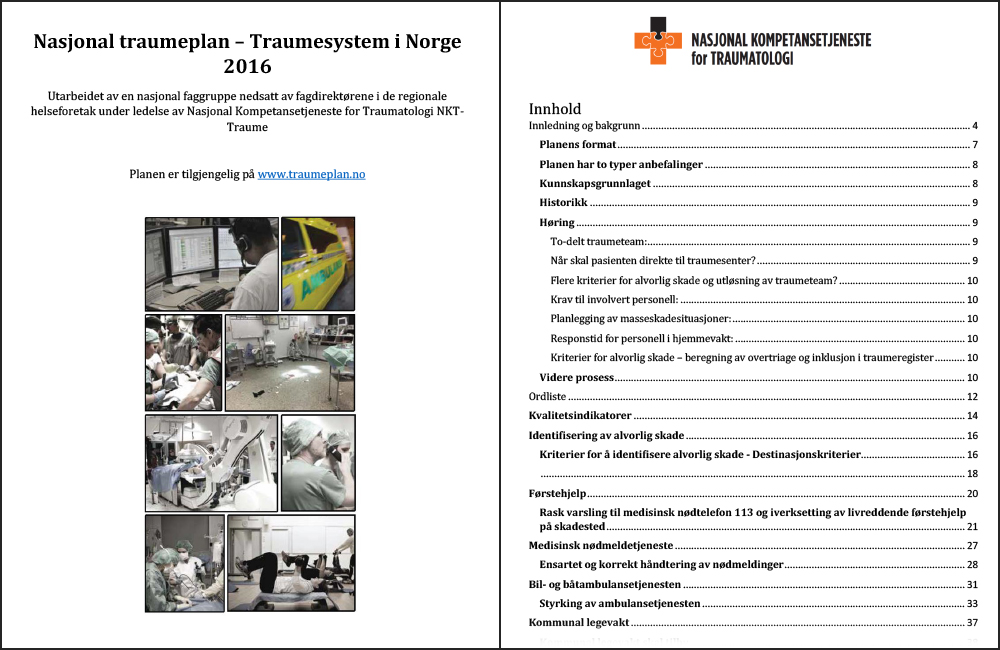
Norwegian Trauma Plan
Introduction
About 10% of the population is injured annually, and 100,000 are injured so seriously that they need treatment in hospital. Annually, 2,500 mostly young and previously healthy people die from injuries. Injuries are the most frequent cause of death in the population under the age of 35-40. The quality of the treatment of serious injuries matters a lot for the outcome in terms of survival and sequelae. The treatment will most often be time-critical, and depends on immediately available and well-prepared expertise. A trauma system is an organization of all resources in the chain that treats the seriously injured patient, where seamless overlapping and information flow is sought in a system without thresholds or bottlenecks. The trauma system therefore encompasses all stages, from prevention to first aid at the scene of the injury to rehabilitation, it includes patient experiences and the implementation of monitoring systems such as the national trauma register.
In 2007, the specialist directors of the regional health undertakings adopted the document "Organisation of the treatment of seriously injured patients - Trauma system". The document was prepared by a group set up by the regional health organizations in 2005, with broad representation from various professional environments. In the document, CEO wrote. Bente Mikkelsen, Helse Sør-East RHF, on behalf of the four regional health undertakings that "The document will be used as the basis for a joint presentation of the case which can possibly be supplemented with necessary additions specifically for the individual regional health undertaking, before it is submitted for board consideration in all the regional the health institutions. The goal is to achieve as great a degree of coordination of the trauma systems as possible."
It still took years before decisions were made in the four RHFs, and the implementation was less coordinated than originally hoped. One of the points in the plan was the creation of a competence center for traumatology. In the work, a number of areas have been identified where it is necessary to prepare proposals for national standards. There is also a need for a body that will be a driving force in practically related trauma research. Therefore, the group believes that a national competence center must be established which, in collaboration with others, will work on the following tasks:
- Guiding standards for how the AMK staff should guide in connection with calls regarding injured patients.
- Develop uniform, national guidelines for the correct requisition of air ambulances for use in all AMK centres.
- Develop national guidelines for trauma care for ambulance services.
- Requirements for documentation of pre-hospital findings and establishment of a standard ambulance record.
- Criteria for activation of trauma teams.
- Criteria for transfer from acute hospital to trauma center (indicative, agreed regionally).
- Criteria for transfer to departments with a national function.
- Guidelines for Content in Transmission Services.
- Education.
- Trauma-related research and quality control.
- Coordination of international collaborative projects.
- Rehabilitation.
- Follow-up of quality assurance at the hospitals.
- On the basis of the inequalities in Norway and the fact that major challenges lie outside the largest cities, the group recommends that such a competence center be organized as a network with representatives from all regions and all levels of trauma treatment.
The National Competence Service for Traumatology (NKT-Traume) was opened on 15 May 2013. The Competence Service made quick contact with the specialist directors to offer to oversee a roll-out of the national trauma plan, and the specialist director meeting on 18 November 2013 commissioned the National Competence Service for Traumatology (NKT-Traume) to lead a revision of "Organisation of the treatment of seriously injured patients - Trauma system' from 2006. The mandate was drawn up after consultation with the Norwegian Directorate of Health, and was decided in March 2014, and delivery was agreed for winter 2015. The working group was appointed by the professional director's meeting following input from NKT-Traume.
Specifications
- Last Updated: 2016
- Author(s): n/a
- Category: Guidelines
- Tags: 2016, Norwegian
PDF Documents
Please login to access file downloads.
